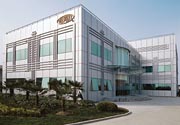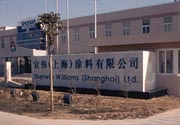China's Coatings Market: Opportunities and Risks

East China ranks first, with manufacturers there accounting for 45% of total volume; Central China accounts for 30%; North China, 15%; and the Northeast, Southwest and Northwest account for the remaining 10%. Large, local single and joint-venture manufacturers focus on relatively high-end products, whereas smaller, privately owned companies and township producers (companies owned by local town authorities) are active in the low-end sector.
Of 18 common types of coatings produced in China, alkyd coatings comprise the single largest group. These are followed by energy-saving, low-VOC coatings (waterborne, powder, high-solids, radiation-cured), which account for 26% of the total. In contrast, such products comprise 80% of the market in North America, the EU and Japan.
China exports relatively low-end products, such as phenolic coatings and modified natural resin coatings to developing countries. On the other hand, it imports high-end polyester and acrylic coatings to satisfy the requirements of new application lines. Within the last two years, 10 global coatings giants have opened facilities in China. To speed up its business expansion in China, Akzo Nobel has built a resin plant that will begin producing acrylic, alkyd and amino resins sometime this year.
Nippon Paint has invested 4.1 billion Japanese yen to expand the production capacity of its Langfang and Suzhou branches to 160,000 tons, its Shanghai branch to 140,000 tons and its Guangzhou branch to 70,000 tons. Thus, Nippon Paint will have a 19% share of the total Chinese coating market by 2005, when the entire project is completed.
American, Canadian, Italian and German manufacturers have built joint-venture facilities and introduced advanced operating lines; Taiwan and Hong Kong companies also are competing with local producers. Surveys show that since 1990 approximately 16 foreign companies have set up solely owned and joint-venture companies with a manufacturing capacity of greater than 20,000 tons. Besides Nippon Paint, ICI plans to build a 50,000-ton manufacturing line in the northern part of China.
Market prospects
Global coating demand is forecast to grow at an average rate of 3.7% from 2004 to 2005. Total shipments will reach about 28.3 million tons. The estimated growth rate in well-developed industrial countries will remain 2.7%; hence, the demand in developing countries will be higher than the global average. The Chinese coating industry will experience stable growth, increasing to 6.6%, and will produce 3 million tons of coatings in 2005.Shipments of Chinese coatings reached 2.2 million tons in 2003, which was an increase of 10% over the previous year. Of the total, 520,000 tons were architectural latex paints, an increase of 15% over the previous year. Driven by the development of Western China, the Olympic Games, other important projects, civil building expansion and the release of corresponding regulations, the Chinese coating market will maintain high growth rates for the next several years.
But, with the economic development in China and a rising standard of living, tougher VOC and toxic compound restrictions have been implemented. Thus, resins and formulations have to be optimized and new additives have to be developed. The "Green Revolution" that sprung up across the world in the 1990s also propels the Chinese coating industry toward more environmentally friendly coatings. The market share of these coatings is increasing each year. Currently in China, more than 100 types of waterborne coatings produced by about 30 companies have earned the "China Environmental Label" from the National Environmental Protection Bureau.
Regardless of the market's profitability prospects, the coating industry needs different types of additives and fillers with various functions and characteristics. Most local Chinese coating manufacturers are unable to provide superior products with dependable quality; variations can occur from one batch to the next. Thus, access to imported, high-quality pigments, additives and fillers is essential. Therefore, the development of the coating industry in China largely depends on the growth of coating additives. Further, inferior manufacturing equipment is another restriction.

Profit issues
Currently, many local coating companies in China have profit margins of less than 10%, which is below the warning line (normally, operating profit is 20 to 30%). That's due to the fierce competition in recent years. No Chinese company is in the top 14 coating companies, as ranked by sales revenue. Large local Chinese companies with relatively more advanced technology, high-end products and high capacity sell their products at an average price of $1.44 per liter, much lower than the average price of $3.19 per liter charged by the top 14 global coating companies and the $2.87 per liter obtained by the top eight Asia-Pacific coating companies.Famous for their elimination of lead and mercury, ICI and Nippon Paint have obtained 30% of the total market share. In the mid and high-end sectors, the two companies control about half the market. Foreign companies pay much attention to high value-added and advanced coatings, such as latex for architecture, automotive and marine, in the Chinese market. Regardless of increasing demand in the coatings market, local Chinese companies still can not make a reasonable profit.
The conflict between foreign investment and local manufacturers' poor profitability will change the industrial structure of the Chinese coatings industry. International coating companies with advantages in capital, technology and product quality will dominate the high-end sector; small local producers will only be able to compete in rural sectors.

Technology level
China has many professional coating research institutes, such as the Changzhou Paint & Coatings Chemical Industry Research Institute, North China Institute of Coating Industry, Qingdao Marine Chemical Research Institute, Institute of Organic Chemistry (Chengdu) of Chinese Academy of Science, and Langfang Petroleum Research Institute, as well as facilities at universities and colleges. Plus, many large companies have R&D centers.The technology behind architectural coatings is well established. These coatings include acrylic, epoxy and polyurethane coatings, where the current focus is on fluorocarbon resins, silicone weather-resistant, environmentally friendly and special multifunctional coatings. Research in marine and petrochemical coatings are anticorrosion and antifouling oriented, including chloridized rubber, epoxy pitch, epoxy zinc rich, pure epoxy and acrylic coatings. Most automotive coatings are bake coatings, including amino acrylic and polyurethane.
The key areas of current research and development involve coatings that are environmentally friendly and multifunctional, such as those that are used on military equipment and for heat insulation, and that are fire-resistant. However, the market demand for these coatings is limited. As for more general coatings, the processing technologies are not that complicated and only a minor investment is required.
Problem areas
Poor marketing strategies of local Chinese coating manufacturers prevent healthy market development. The main approach is to imitate the competition; local producers imitate foreign companies, and small producers imitate large companies. Since Nippon Paint and ICI promoted "3 in 1" and "5 in 1" latex, almost all Chinese coating manufacturers have given their products names that are similar to the products of those brands. Leading companies and small producers also have similar promotional pamphlets.
The same chemical components, properties and notes can be easily found in different specifications everywhere, particularly in the wood-coatings market. Similar specialty stores have sprung up, using the same types of promotion. These similar promotional strategies push down profit levels and restrict the development of the Chinese coatings industry.
SIDEBAR
The Investment Boom in China
A virtual flood of companies are opening new facilities in China, investing substantial resources into current facilities, and partnering with Chinese companies. They are trying to capture market share in a region that has and will continue to experience significant growth, as well as to locate closer to their suppliers and customers. The paint and coatings industry is no exception. Below are some of the companies in the paint and coatings industry that have recently announced they have made or would be making substantial investments in China.Akzo Nobel (Arnhelm, The Netherlands) announced plans to build two powder coating manufacturing plants, one in Langfang between Beijing and Tianjin, and one in Guangdong Province in southern China adjacent to Akzo Nobel's existing powder operation in Shenzhen. (NewsWatch, March)
Sherwin-Williams (Cleveland) Chemical Coatings Division opened two facilities to serve product finishers in the Asia-Pacific region. A 116,000-square-foot plant in Shanghai manufactures liquid and powder coatings. The facility in Dongguan is capable of modifying liquid coatings for color, gloss and viscosity. The company also recently acquired a majority interest in Shanghai Kinlita Chemical Co. Ltd. In Shanghai, a manufacturer of electrodeposition coatings for trucks and buses. (NewsWatch, June)
BASF Coatings (Mount Olive, NJ) says it plans to expand coil-coating operations in Shanghai with the addition of production capabilities. (NewsWatch, June) Also, the company supplies primers, basecoats and clearcoats from its Tokyo facility to a new automotive manufacturing facility jointly operated by Nissan and Dongfeng Motor Corp. in Guangdong Province. In the future, those coatings will be supplied by BASF's Shanghai facility.
BYK-Chemie (Wesel, Germany) started operations at two new application-technology labs in Shanghai and Guangzhou. (NewsWatch, May)
DuPont (Wilmington, DE) acquired additional equity in its DuPont Red Lion joint ventures in Beijing and Changchun. It now owns 76% of the Beijing joint venture and 100% of the Changchun business.
The Chemquest Group Inc. (Cincinnati), a strategic management firm specializing in coatings announced plans to expand its consulting services into China and open an office there. (NewsWatch, December 2003)
The Dow Chemical Co. (Midland, MI) started production at its 41,000-metric-ton-per-year epoxy resin plant in China. It will produce solid epoxy resins for use primarily in powder coatings, solid solution epoxy resins for marine and protective liquid coatings and brominated epoxy resins for the production of electrical laminates. (NewsWatch, September 2003)
Looking for a reprint of this article?
From high-res PDFs to custom plaques, order your copy today!



